1993 CHEVROLET CORVETTE warning lights
[x] Cancel search: warning lightsPage 113 of 370
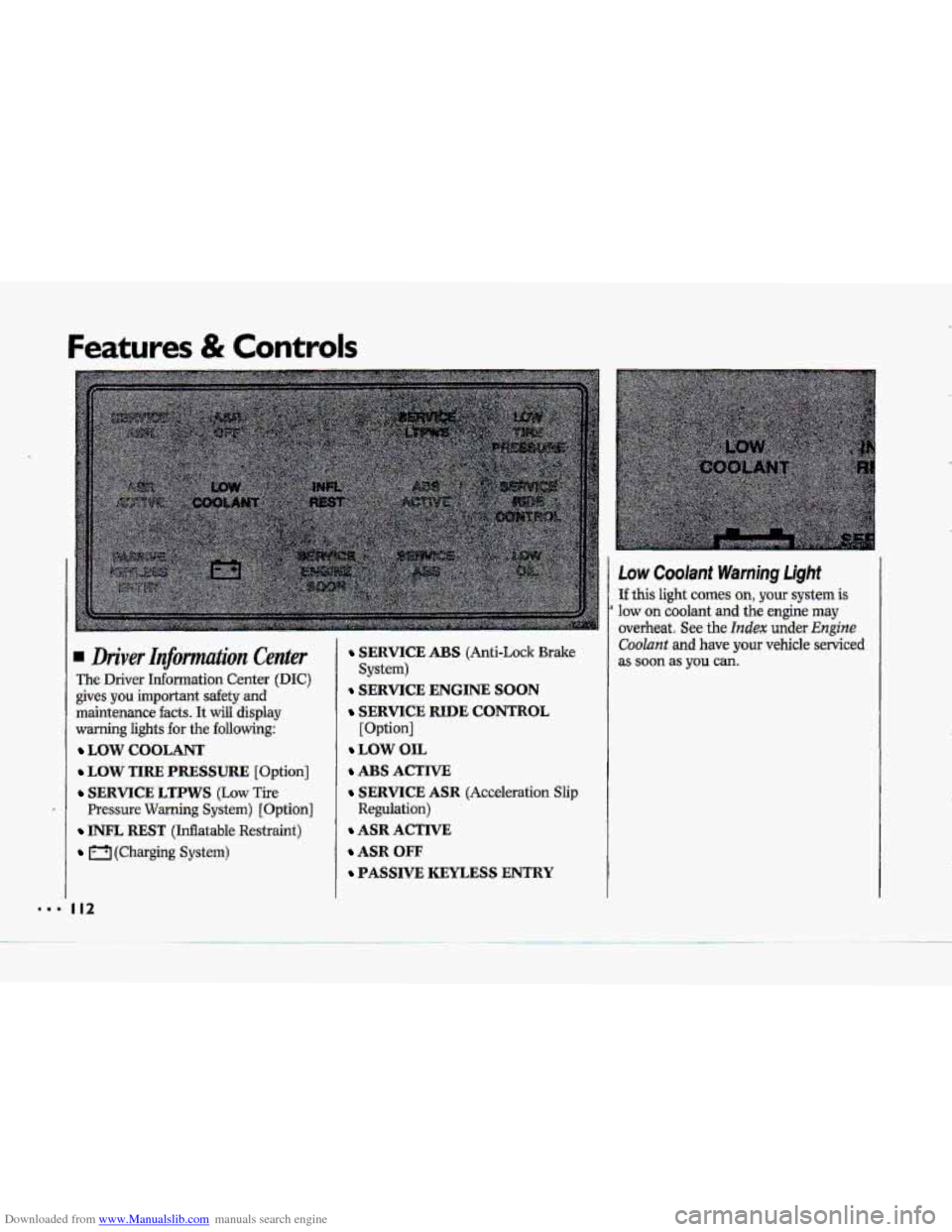
Downloaded from www.Manualslib.com manuals search engine Features & Controls
..I I
Low Coolant Warning Light
If this light comes on, your system is
overheat. See the Index under Engine
Coolant and have your vehicle serviced
a low on coolant and the engine may
Driver Infomtation Center
The Driver Information Center (DIC)
gives you important safety and
maintenance
facts. It will display
warning lights
€or the following:
LOW COOLANT
LOW TIRE PRESSURE [Option]
SERVICE LTPWS (Low Tire
Pressure Warning System) [Option]
INFL REST (Inflatable Restraint)
(Charging System)
I12
SERVICE ABS (Anti-Lock Brake
SERVICE ENGINE SOON
SERVICE RIDE CONTROL
[Option]
LOW OIL
ABS ACTIVE
SERVICE ASR (Acceleration Slip
Regulation)
ASR ACTIVE
ASR OFF
PASSIVE KEYLESS ENTRY
System) as soon as you can.
Page 116 of 370
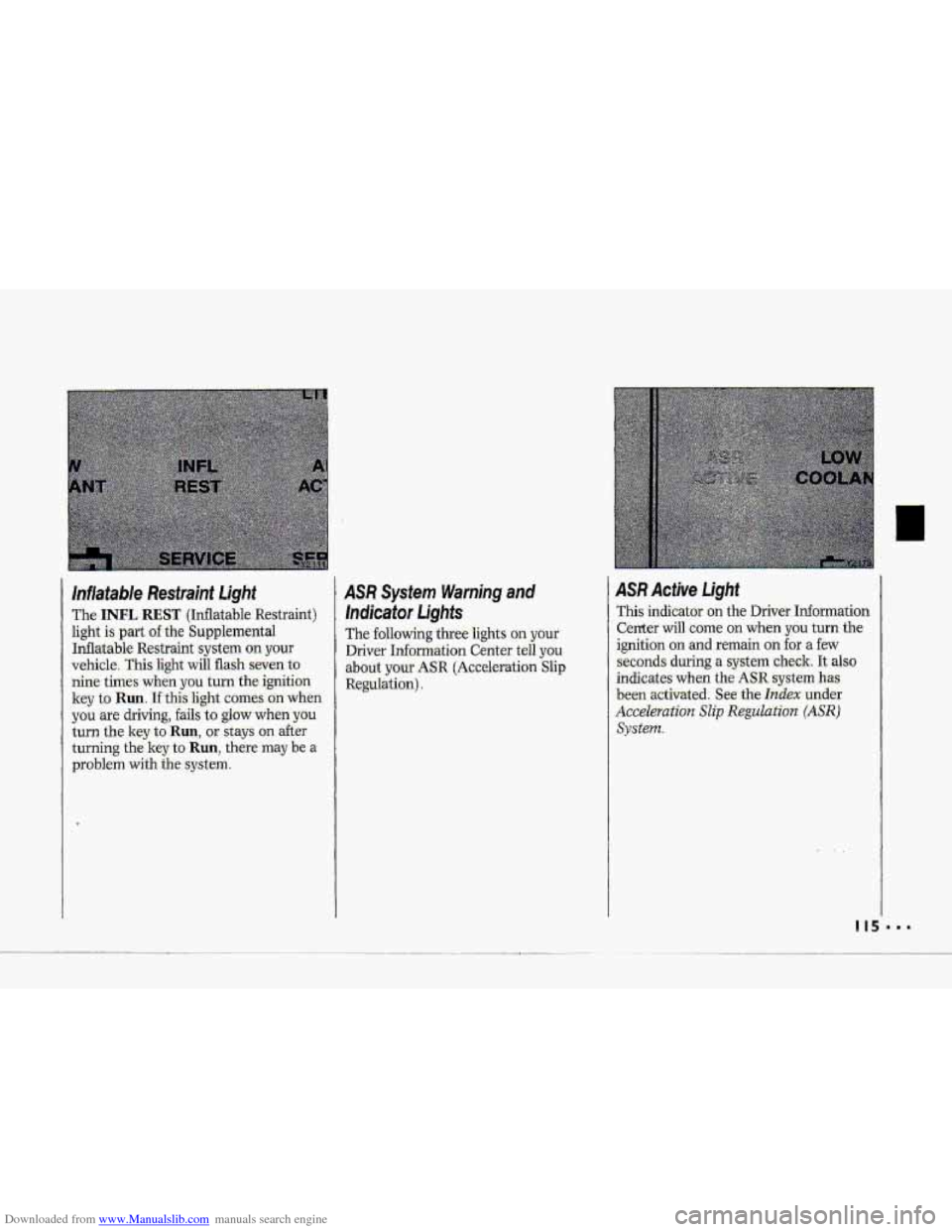
Downloaded from www.Manualslib.com manuals search engine ...-
I
I
/iflatable Restraint light
The. INFL REST (Inflatable. Re'str'aint)
light
Is part ofthe Supplemental
Inflatable
Restraint system on your
vehicle. This light will flash -seven t,o
hine ti-mes when you turn the ignition
key
to Ruil. If: thklight comes oh.when
you are driving, fails to glow when you
turn the key to Run, or stays on after
turning the key to Run, there may be a
problem with the system.
.ASR System. Warning and
lndicator Lights
The following three 1ights.m your
Driver Information Center tell you
abo.ut your .ASR (Ac.ce1eratio.n Slip
Regulation),
ASR Acfive Light
This indicator on the Driver- Information
Center will
come on when you turn the
ignition
on and remain on for a few
seconds during
a system check. It also
indicates when the ASR system has
been activated. See the Index under
Accel@rution Slip Regulation. (ASR)
System.
Page 168 of 370
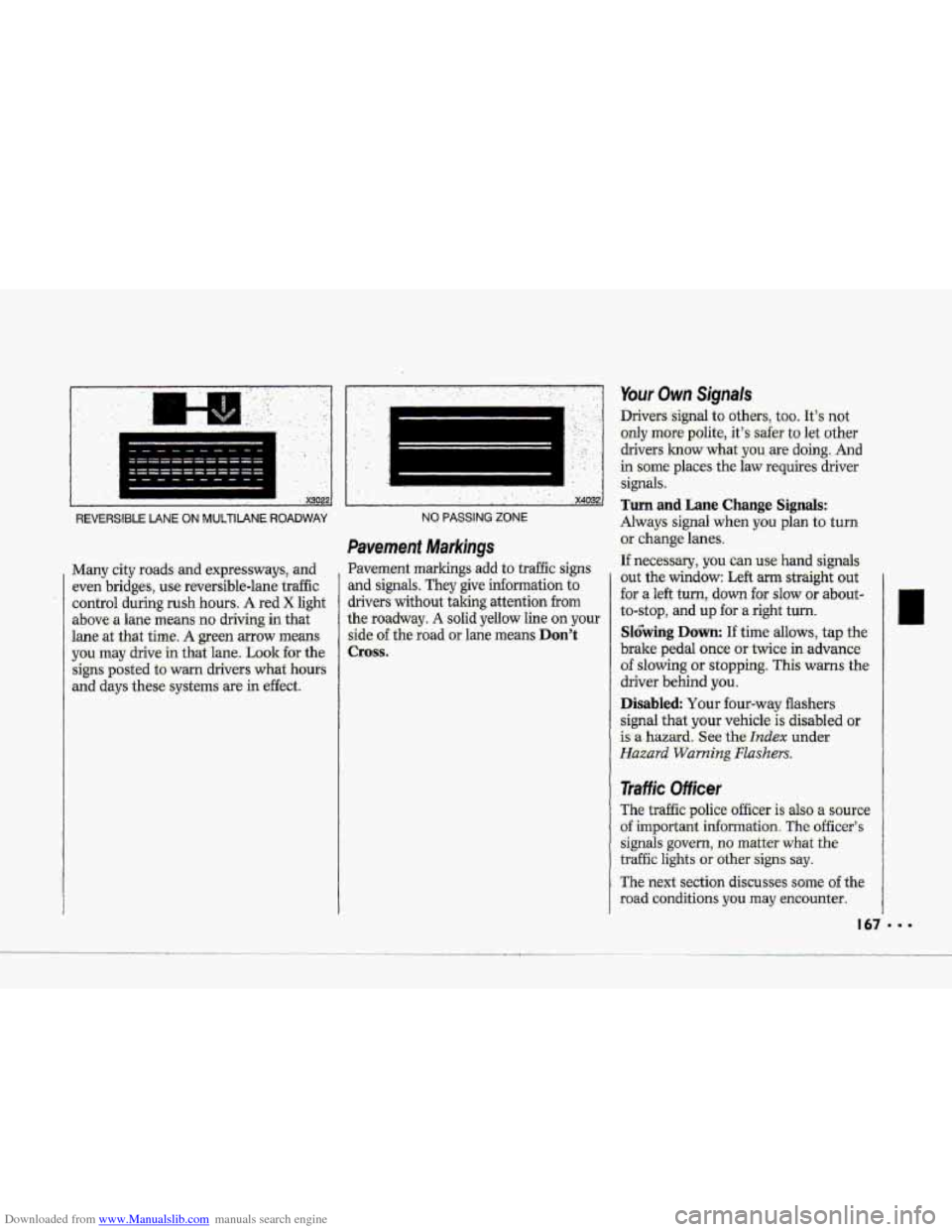
Downloaded from www.Manualslib.com manuals search engine c
R
II
I
1 .---
I I
1
,, -' , . x3022
REVERSIBLE LANE ON MUlTIIANE ROADWAY
Many city roads: and expressways, and
even bridges, use reuersible-lane traffic
control during
rush hours. A red X light
above- a lane means no driving in that
lane
at .that time. A green mow means
you may drive in that lane. Look €or the
signs posted to warn drivers
what hours
and days these = ,-.. systems are in effect.
.. ........... ........................ ... ,. ., ,. . ... . ' .' '. , ..
! ' x4032
NO PASSING ZONE
Pavement Markings
Pavement markings add to traffic signs
and signals. They give information to
drivers without iaking attention
from
the roadway. A solid yellow line on your
side of the road or lane means Don't
Cross.
Your Own Signals
Drivers -signal to other.s, too. It's not
only more polite.,. it's safer to let other
drivers
1mow what-you are doing-. And
in some' places the law requires driver
signals:
Turn and Lane Change Signals:
Always signal when you plan to turn
or .change lanes.
If neces-ssary, you can use hand signals
out the window: Left arm straight out
'for a left turn, down for slow :or about-
to-stop, and up for .a right turn.
Sl6bing Down: If time allows, tap the
brake pedal once or twice in advance.
of slowing or stopping. This warns the
driver behind
you.
Disabled Your four-wtiy flashers
signal
that. your vehicle is disabled or
is a hazard. See the hdex under
Hazard Warning Flashers.
Traffic Officer
The traffic police officer is also a source
of important information The officer's
signals govern, no matter what the
traffic lights or othersigns say.
The next section discusses some of the
road conditions you may encounter.
Page 185 of 370
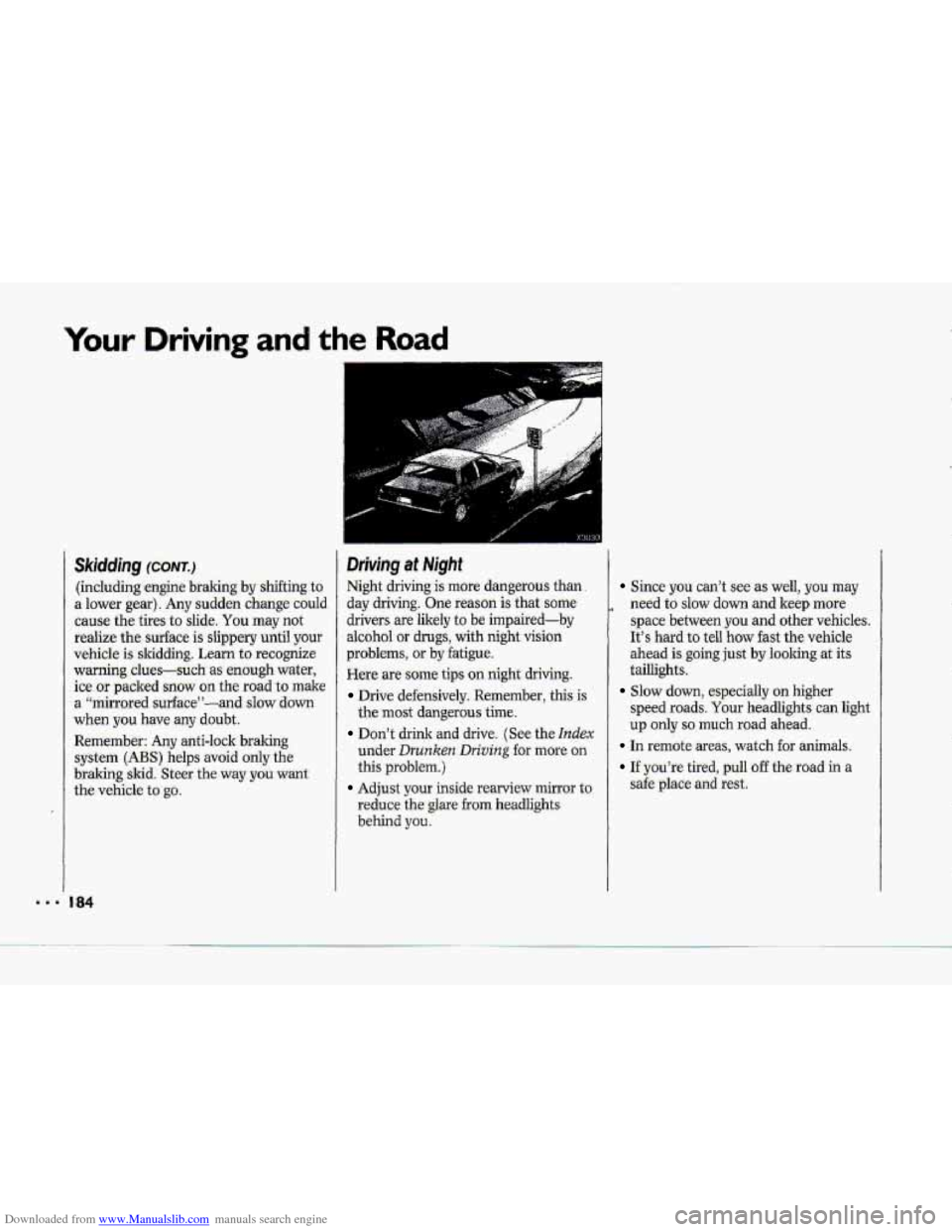
Downloaded from www.Manualslib.com manuals search engine Your Driving and the Road
Skidding (CONT.)
(including engine braking by shifting to
a lower gear). Any sudden change could
cause the tires
to slide. You may not
realize
the surface is slippery until your
vehicle
is skidding. Learn to recognize
warning clues-such as enough water,
ice or packed snow
on the road to make
a ‘‘mirrored surface”-and slow down
when you have any doubt.
Remember: Any anti-lock braking
system
(ABS) helps avoid only the
bralung skid.
Steer the way you want
the vehicle to
go.
Driving at Night
Night driving is more dangerous than.
day driving. One reason is that some
drivers are likely
to be impaired-by
alcohol or drugs, with night vision
problems, or by fatigue.
Here are some tips
on night driving.
Drive defensively. Remember, this is
the most dangerous time.
Don’t drink and drive. (See the Index
under Drunken Dn’ving for mure on
this problem.)
Adjust your inside rearview mirror to
reduce
the glare from headlights
behind you.
Since you can’t see as well, you may
need
to slow down and keep more
space between you and other vehicles.
It’s hard to teil how fast the vehicle
ahead
is going just by looking at its
taillights.
speed roads. Your headlights can light
up only so much road ahead.
Slow down, especially on higher
In remote areas, watch for animals.
If you’re tired, pull off the road in a
safe place and rest.
Page 191 of 370
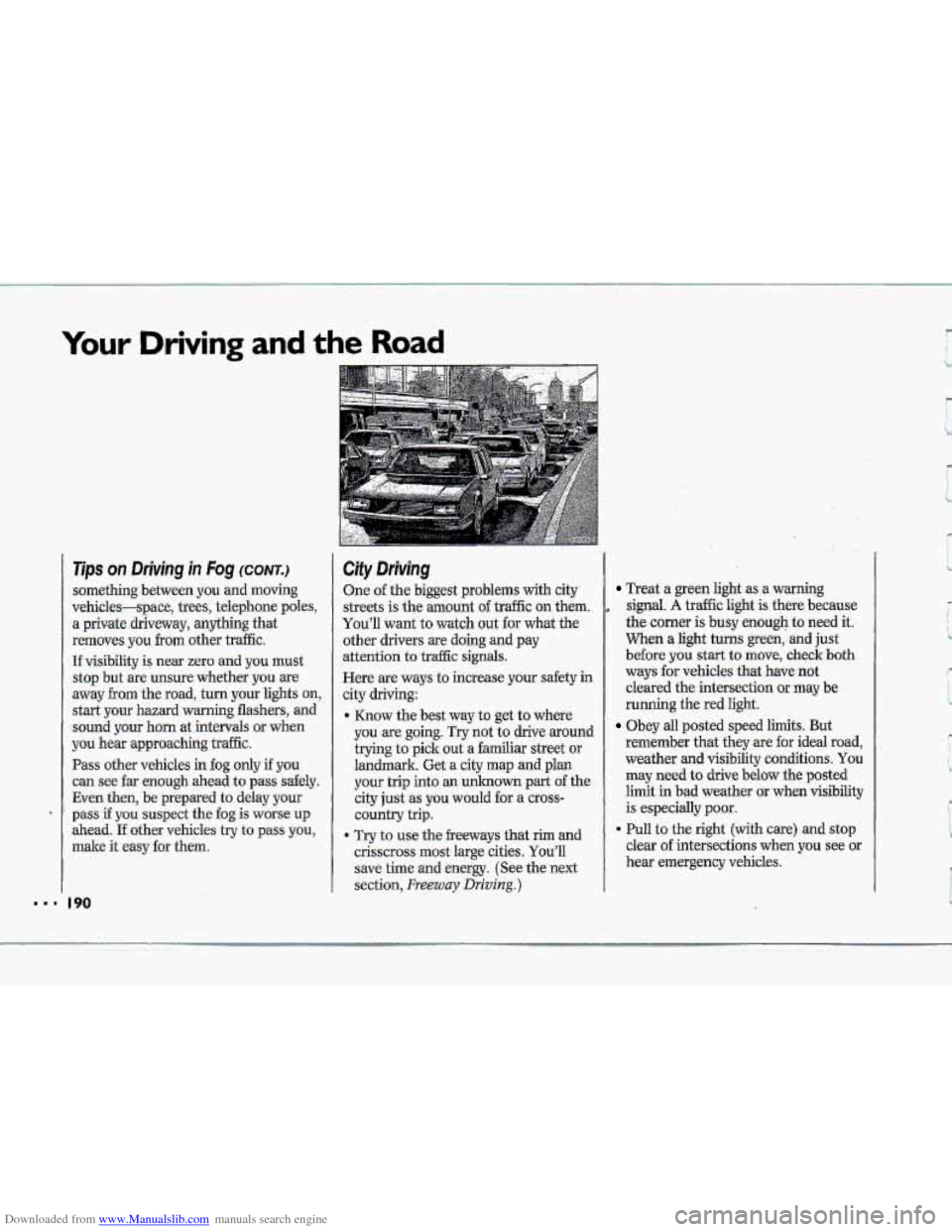
Downloaded from www.Manualslib.com manuals search engine Your Driving and the Road
Tips on Driving in Fog (CONT.)
something between you and moving
vehicles-space, trees, telephone poles,
a private driveway, anything that
removes you
from other trafic.
If visibility is near zero and you must
stop but are unsure whether you are
away
from the road, turn your lights on,
start your hazard warning flashers, and
sound your horn at intervals or when
you hear approaching traffic.
Pass other vehicles in fog only if you
can see far enough ahead to pass safely.
Even then, be prepared to delay your
pass if you suspect the fog is worse up
ahead. If other vehicles try to pass you,
make it easy for them.
City Driving
One of the biggest problems with city.
streets
is the amount o€ traffic on them.
You’ll want to watch
out for what the
other drivers are doing
and pay
attention
to traffic signals.
Here are ways to increase your safety in
city driving:
* Know the best way to get to where
you-are going.
Try not to drive around
trying to pick out a familiar street or
landmark. Get a city map
and plan
your trip into an unknown part of the
city
just .as you would for a cross-
country trip.
9 Try to use the freeways that rim and
crisscross
most large cities. You’ll
save time
and energy. (See the next
section,
Freeway Driving.)
Treat a green light as a warning
.signal, A traffic light is there because
the corner
is busy .enough to need it.
When a light turns green, and just
before you start to move, check both
ways for vehicles. that have not
cleared
the intersection or may be
running the red light.
Obey all posted speed limits. But
remenher that they are
for ideal road,
weather
and visibility conditions. You
may need to drive bglow the .posted
limit
.in b.ad weather or when visibility
is especially poor,
clear
of intersections when you see or
hear emergency vehicles.
9 Pull to the right (with care) and stop
c
Page 193 of 370
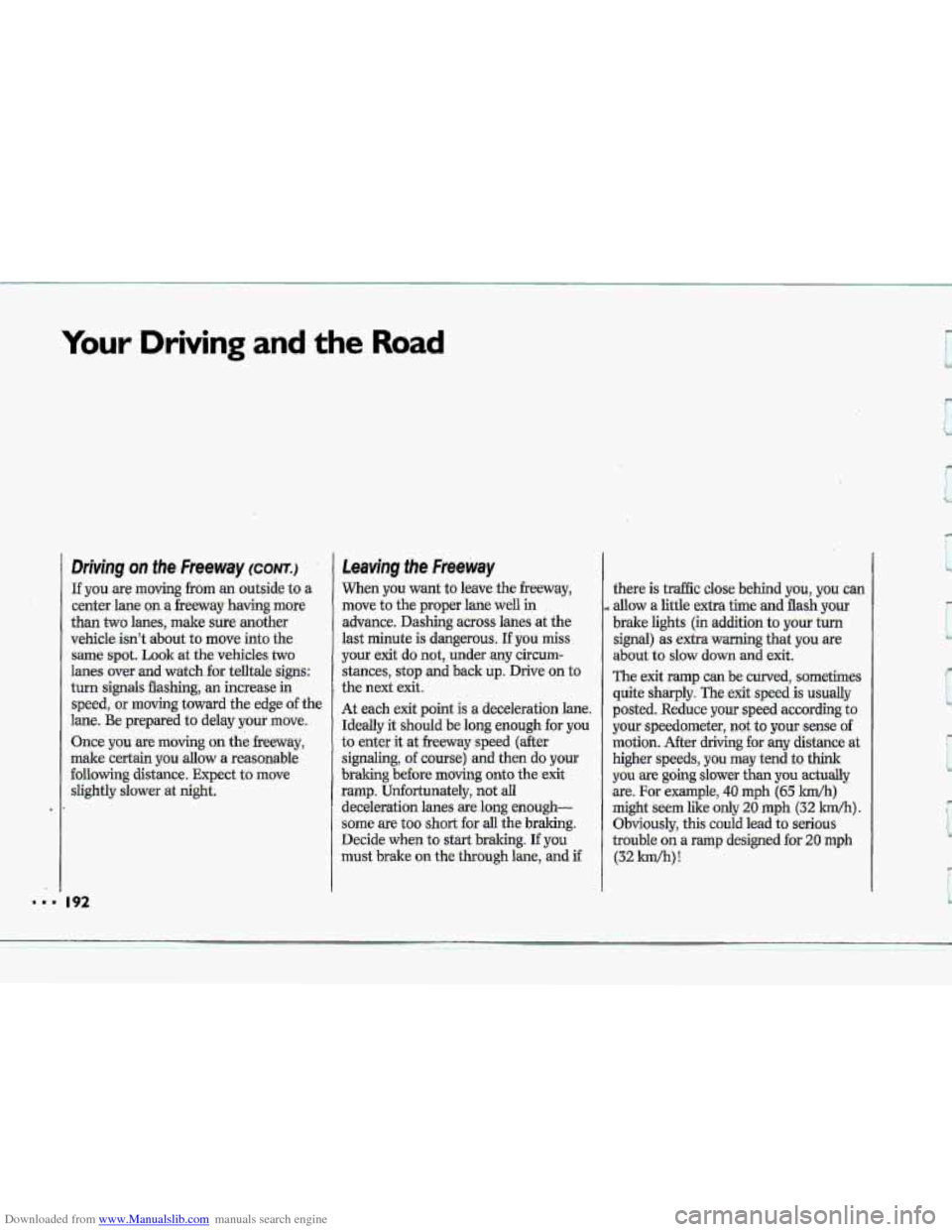
Downloaded from www.Manualslib.com manuals search engine Your Driving and the Road
Driving on the Freeway (CONTJ
~fyou are moving from an outside to a
center lane. on a freeway having more
than two lanes, make sure another
vehic1e;isn't about to move
into the
same spot. Look at the 'vehicles two
lanes over and watch for telltale signs:
turn
signals flashing? an increase in
speed, or
moving toward the edge-of the
lane. Be prepared to delay
your move.
Once you are moving on the freeway,
make certain you allow a reasonable
following distance. Expect
to move
slightly slower at night.
Leaving the Freeway
When you want to leave the freeway,
move to the proper lane well in
advance. Dashing across lanes at the
last minute is dangerous.
If you miss
your exit do not,.under any circum-
stances,
stop and back up. Drive on to
the next
exit.
At each exit point is a deceleration lane.
Ideally it
should be long enough for you
to enter it at freeway speed
(after
signaling, of course) and then do your
braking before
moving onto the ,exit
ramp. Unfortunately, not all deceleration lanes are
long enough-
.some are too short for all the braking.
Decide when
to start braking. If you
must brake on the.through lane, and if
there is traffic close behind you, yau can
allow a little extra tirrie and flash your
brake lights (in addition to your turn
signal)
as extra warning that you are
about to slow down and exit.
The exit ramp
can be curved, sometimes
quite sharply. The exit speed
is usually
posted. Reduce
your speed according to
your speedometer, not-to your sense of
motion. After driving.for any distance at
higher speeds,
you may tend to- think.
you -we going slower than you actually
are. For example,
40 mph (65 I&)
might seem like only 20 mph (32 Wh) .
Obviously, this could lead to serious
trouble on a
ramp designed for 20 rnph
(32 W)!
P
be
Page 205 of 370
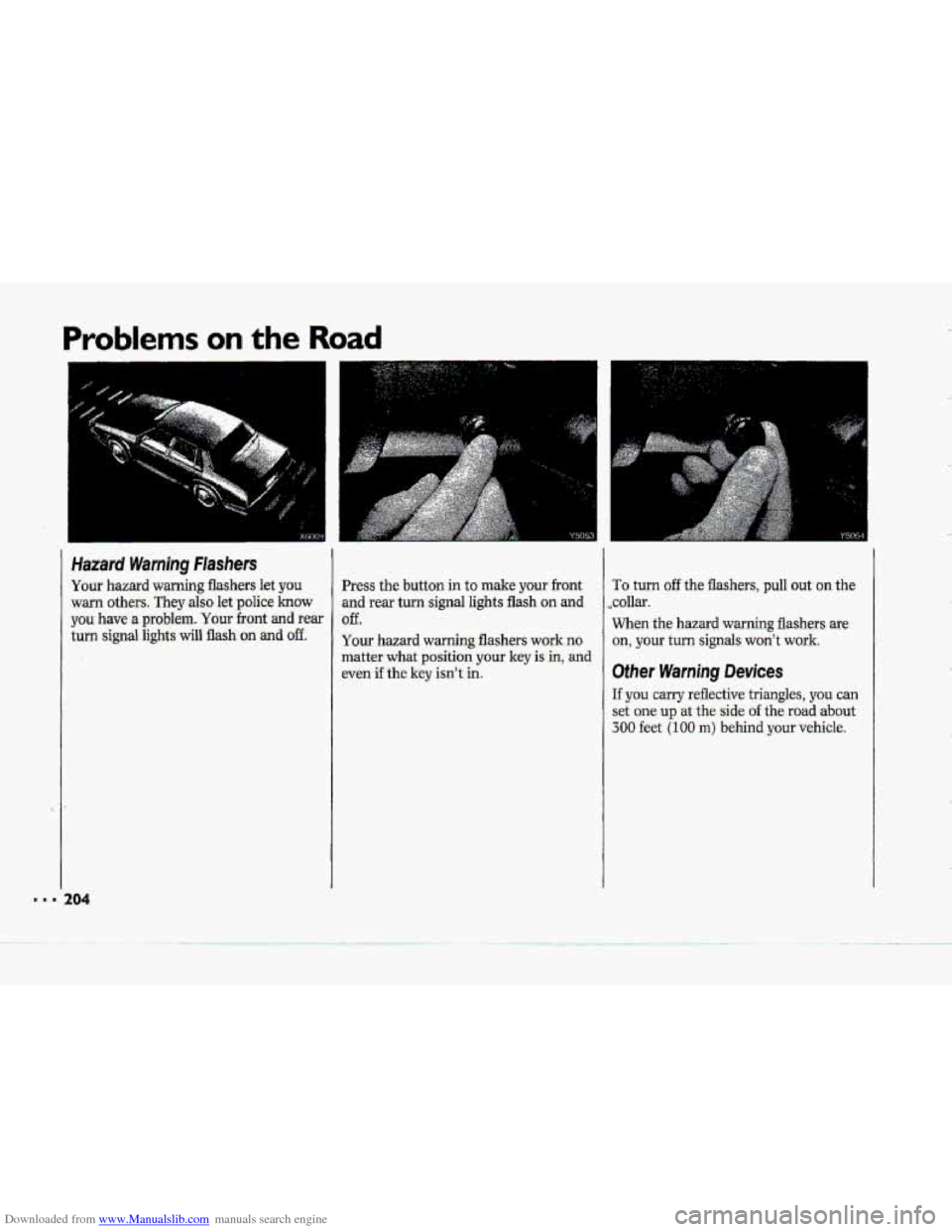
Downloaded from www.Manualslib.com manuals search engine Problems on the Road
‘A
Hazard Warning Flashers
Your hazard warning flashers let you
warn others. They also let police know
you have a problem. Your front and rear
turn signal lights will flash on and off.
204
Press the button in to make your front
and rear turn signal lights flash on and
Off.
Your hazard warning flashers work no
matter what position your key is in, and
even if the key isn’t in.
To turn off the flashers, pull out on the
.*collar.
When the hazard
warning flashers are
on, your turn signals won’t work.
1 Other warning Devices
If you carry reflective triangles, you can
set one up at the side of the road about
300 feet (100 m) behind your vehicle.
Page 238 of 370
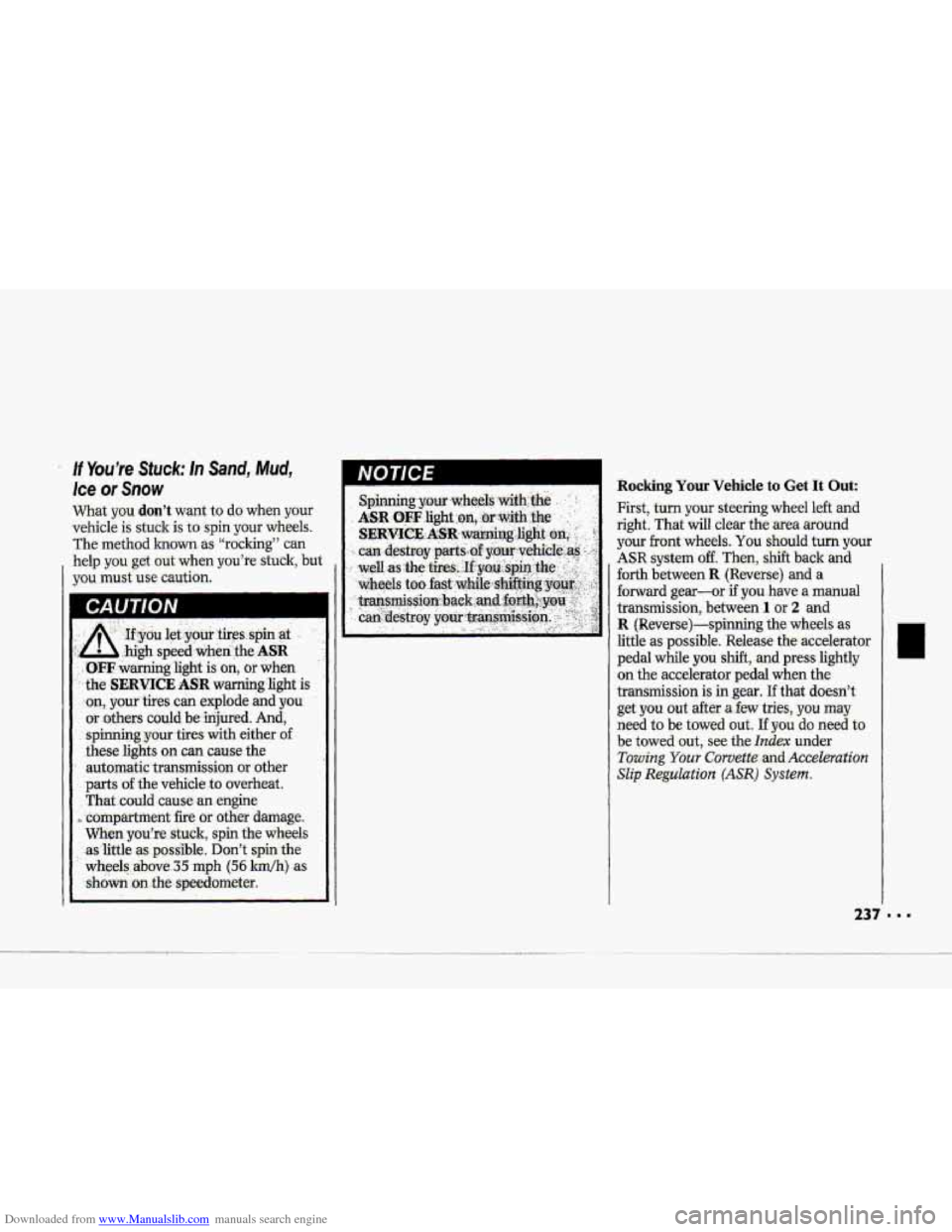
Downloaded from www.Manualslib.com manuals search engine c
c-
If You’re Stuck: In Sand, Mud,
Ice or Snow
What you don’t want to do when your
vehicle is stuck is to spin your wheels.
The method
known as “rocking” can
rou must use caution. I help you get out when you’re stuck, but
CAUT/UN I
A: If :you let.your :tires. spin -at
high speed.when the ASR
, . ‘OFE warning light is on, or when
“the SERVICE ASR warning light is
‘on, your tires can explode and you
or others could be injured. And,
spinning your tires with either of
these lights on can cause the
automatic transmission
or other
parts of the vehicle to overheat.
That could cause an engine
compartment fire or other damage.
When you’re stuck, spin the wheels
as little as possible. Don’t spin the
wheels above 35 mph (56 M) as
shown on the speedometer.
Rocking Your Vehicle to Get It Out:
First, turn your steering wheel left and
right. That will clear the area around
your front wheels. You should turn your
ASR system off. Then, shift back and
forth between R (Reverse) and a
forward gear--or if you have a manual
transmission, between 1 or 2 and
R (Reverse)-spinning the wheels as
little as possible. Release the accelerator
pedal while
you shift, and press lightly
on the accelerator pedal when the
transmission is in gear.
If that doesn’t
get
you out after a few tries, you may
need to be towed out.
If you do need to
be towed
out, see the Index under
Towing Your Corvette and Acceleration
Slip Regulation (ASR) System.
237